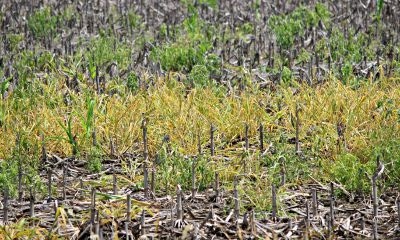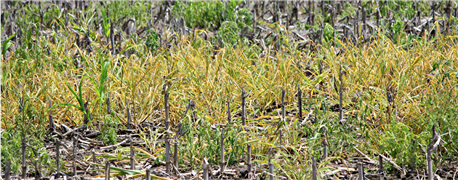
University of Missouri Extension weeds scientist Kevin Bradley offers a five-step approach for selection a soybean herbicide program for the 2016 season.

1. Consider a fall herbicide application. Fall herbicides are an effective tool for winter annual weeds and especially for marestail. Some of the more effective fall residual herbicides for the control of marestail in soybean include Autumn Super and any of the chlorimuron-containing products like Canopy, Canopy EX, Cloak, Cloak EX, Valor XLT, Authority XL, and others. These herbicides should be combined with a base program of glyphosate plus 2,4-D and/or dicamba to control any seedlings and rosettes present at the time of application. Another option is to leave the residual out of the fall application and wait to apply a full rate of a residual herbicide in the spring.
2. Start weed-free next season with tillage operation or burndown herbicide application. Farmers cannot afford to plant into weeds that have not been adequately controlled or that are already emerged at the time of planting. It's likely you will never catch up. In addition, too many resistant weed species will not be controlled in-crop if they have emerged by the time of planting.
3. Apply a full use rate of a pre-emergence, residual herbicide. For waterhemp, some of the most effective pre-emergence residual herbicides include the group 14 herbicides such as those that contain flumioxazin and sulfentrazone (Authority products, Envive, Fierce products, Sonic, Valor products) and the group 15 herbicides such as those that contain metolachlor (Dual II Magnum, Boundary, Prefix), dimethenamid (Outlook, OpTill PRO), pyroxasulfone (Zidua, Fierce), and acetochlor (Warrant, Warrant Ultra). Trifluralin (Treflan, group 3) and metribuzin (Sencor, Tricor., group 5) can also provide good waterhemp control. Apply a full use rate of whichever product you have chosen.
4. Scout fields after emergence. Group 14 (or PPO) herbicides like Cobra, Flexstar, Marvel, Phoenix, Ultra Blazer, and others will not provide adequate control of waterhemp that is greater than 4 inches in height at the time of application. The same is true of glufosinate (Liberty, group 10) in Liberty Link soybean. If you apply one of these herbicides to waterhemp that is greater than 4 inches in height and aren't happy with the outcome, it isn't necessarily because the weed is resistant; the products aren't labeled for waterhemp that size in the first place.
When it comes to post-emergence applications of the group 14 herbicides and Liberty is that coverage is critical. So, higher gallonage per acre and nozzles that provide good coverage will be critical.
5. "Layered" or "overlapping residual" herbicide programs work on waterhemp. The technique involves a pre-emergence residual herbicide before planting, followed by an in-crop application of another residual herbicide (Anthem, Cinch, Dual II Magnum, Outlook, Prefix, Warrant, Zidua), usually made at the same time as a glyphosate application in Roundup Ready soybean, or Liberty application in LibertyLink soybean. This herbicide strategy won't work on every weed species, but it does provide effective residual control of waterhemp and a variety of other small-seeded broadleaf weeds and grasses.
About the Author(s)
You May Also Like






